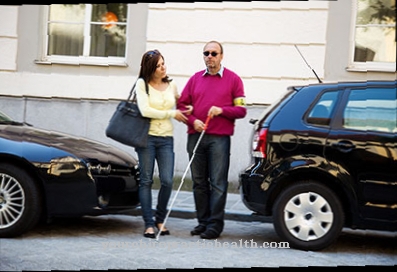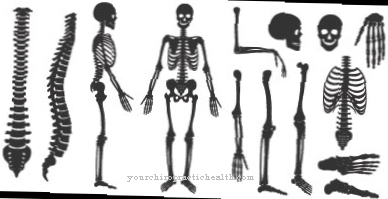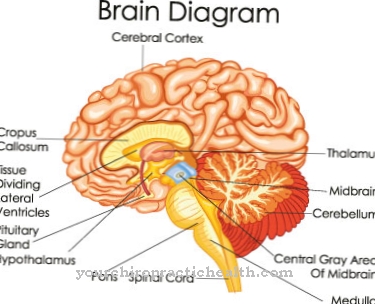Atrial fibrillation is probably the most common rhythm disturbance of the heart, which increases significantly with age. Ten percent of people over the age of 70 have this “supraventricular tachyarrhythmia”.
What is atrial fibrillation?
That is, there is an irregular and fast heartbeat that develops in the left atrium. In comparison, only 1% of people over 50 years of age have this arrhythmia. The causes, examination methods, treatment and course options as well as preventive measures are also discussed.
The heart has its own stimulus generation and conduction system. At Atrial fibrillation there are areas in the atrium that are also electrically excited.
This leads to very rapid movements of the heart walls with an atrial fibrillation frequency between 350 - 600 / min. As a result, there is no hemodynamically effective atrial contraction, which alters the cardiac output (blood volume which is pumped from the heart into the circulation within one minute). Because of the AV node, only a small part of the atrial actions are transferred to the ventricles.
causes
At about 15% of the Atrial fibrillation patients there is primary atrial fibrillation with heart health. The most common causes are cardiac.
These include coronary heart disease, heart attack, heart failure and mitral valve disease in 50% of cases. Other heart diseases that can cause atrial fibrillation are cardiomyopathy, myocarditis, heart surgery. Extracardiac causes are also known, such as thyroid disease, high blood pressure, pulmonary embolism and certain medications.
Sufferers complain of palpitations with dizziness, brief loss of consciousness (syncope) and shortness of breath with decreasing cardiac output.
Symptoms, ailments & signs
Many patients hardly notice the atrial fibrillation, others react with considerable complaints. Especially people who have got used to the disease belong to the first group. With them, the atrial fibrillation has mostly developed chronically without being noticed. Not infrequently they are plagued by dizziness and tiredness.
A reduced performance is then ascribed to other conditions such as stress or private problems. Atrial fibrillation per se is initially not life-threatening. However, it can lead to serious consequential damage if it is not treated. Clear symptoms involve the heart, which is beating irregularly.
Sick people are aware of the pounding of their heart. This suddenly beats very quickly. This sensation is often accompanied by chest pain. Sometimes shortness of breath occurs, which is immediately assessed as threatening. The signs described have an impact on the psyche. A sudden, incomprehensible fear occurs.
Atrial fibrillation can lead to further long-term effects if it is not treated professionally. These mainly affect older people. Statistically, people over the age of 70 are particularly affected. It is not uncommon for them to suffer a stroke. Even embolisms in the legs or in the cerebral vessel are possible.
Diagnosis & course

The diagnosis of Atrial fibrillation takes place after recording atrial fibrillation using a resting ECG or while recording a long-term ECG. Depending on the course or duration of the atrial fibrillation, there is a further classification.
There are:
1.) Atrial fibrillation diagnosed for the first time.
2.) Paroxysmal atrial fibrillation, which usually limits itself within 48 hours to a maximum of 7 days.
3.) Persistent or persistent atrial fibrillation, which should be converted back into the sinus rhythm.
4.) A long-lasting atrial fibrillation over 1 year, which should be converted into the sinus rhythm.
5.) A permanent atrial fibrillation in which atrial fibrillation has been accepted and is rate-controlled.
The most common complication of atrial fibrillation is the formation of blood clots, which can cause an embolism. 20% of all strokes are due to atrial fibrillation. The longer the atrial fibrillation lasts, the greater the risk.
Complications
Untreated atrial fibrillation leads to various complaints and health complications. If the disease is associated with a drop in heart rate, dizziness, weakness and syncope, a brief loss of consciousness, are among the possible consequences. In addition, symptoms such as palpitations and shortness of breath can occur.
Insufficient pumping power can cause pulmonary congestion, which can lead to life-threatening pulmonary edema. In the long term, acute atrial fibrillation turns into permanent atrial fibrillation. Such a severe course increases the risk of consequential damage considerably: embolism and thus also strokes and cardiovascular concomitant diseases can occur.
In the most severe case, a heart attack occurs and the patient dies as a result. People with coronary artery disease may have an angina attack or an acute heart attack. There are also risks involved in treating atrial fibrillation. Implanting a defibrillator can cause injury or infection, and rejection of the device cannot be ruled out.
Electrical cardioversion can cause abnormal heart rhythms or a heart attack in the case of an undetected valve defect or hypothyroidism. The anesthetics pose additional risks and can cause side effects in some patients.
When should you go to the doctor?
Arrhythmias of the heart, including atrial fibrillation, should be diagnosed and treated as early as possible. Atrial fibrillation is usually frightening for those affected, because the heart races and suddenly loses its rhythm. This cardiac arrhythmia often lasts no longer than a few minutes, rarely hours or days.
So the greatest danger lies in ignoring the symptoms and postponing a doctor's visit. Atrial fibrillation, however, can lead to serious, even life-threatening health disorders. If timely treatment has not been initiated due to a late diagnosis, atrial fibrillation can also take a chronic course. Then the chances of recovery decrease considerably because the heart rhythm can then only be returned to normal with difficulty.
Atrial fibrillation embolism and strokes could often be prevented by a timely presentation to the cardiologist. Atrial fibrillation can be diagnosed well and reliably with a simple ECG or long-term ECG. Certain pre-existing conditions such as obesity, diabetes, heart failure or hypertension increase the risk of developing atrial fibrillation considerably.
Therefore, especially patients with these additional risk factors should take even the smallest cardiac arrhythmias seriously and consult a doctor immediately in order to avoid worse damage. Since atrial fibrillation, a special arrhythmia of the heart, occurs more frequently with age, older people should have a cardiologist examined at regular intervals. Atrial fibrillation can then also be an incidental finding, because it is not always noticed by those affected.
Treatment & Therapy
Therapeutically, there is frequency control on the one hand and rhythm control on the other, which are prognostically equivalent.
The frequency control is carried out with drugs using beta blockers, verapamil (less often) or digitalis preparations. The aim is to lower the heart rate. There are forms of atrial fibrillation with a very low heart rate, which then only increases slightly under stress. This is often an indication for pacemaker implantation.
The rhythm control of atrial fibrillation involves converting the heart rhythm into a sinus rhythm. This can also be done with medication or with an EKG-triggered electrocardioversion. In drug therapy, a distinction must be made between patients with and without heart disease. Patients without heart disease can be placed on class I antiarrhythmics such as flecainide or propafenone.
In the case of paroxysmal atrial fibrillation, a pill-in-the-pocket concept with a single dose of antiarrhythmics can be tried. Patients with heart disease are placed on amiodarone in an inpatient setting. Amiodarone is the most effective antiarrhythmic, but it also has many side effects.
Furthermore, an EKG-triggered electrical cardioversion can be performed under short anesthesia. A current surge is emitted from the outside. Before doing this, the duration of the atrial fibrillation must be taken into account. If this persists for longer than 48 hours, thrombi in the heart must be excluded by means of transesophageal echocardiography (swallowing ultrasound of the heart). Or you can take blood-thinning agents (anicoagulants) for at least four weeks and then perform electrical cardioversion.
You can find your medication here
➔ Medicines for cardiac arrhythmiasprevention
Depending on the risk of thromboembolism, blood-thinning therapy is also carried out temporarily or for life. This will reduce the risk of stroke. Marcumar and Falithrom and, for some time now, dabigatran and rivaroxaban are available for this.
There is a high atrial fibrillation recurrence rate of 30% within one week and 75% after one year in patients after electrical cardioversion. For this reason, antiarrhythmic drugs are often prescribed for a longer period to avoid atrial fibrillation. In addition, there are catheter ablation procedures in the form of high-frequency current or cold, in which the sites of excitation formation of atrial fibrillation are sought out and obliterated.
Aftercare
Regular follow-up exams are extremely important for patients with atrial fibrillation. All patients with atrial fibrillation and after the ablation are treated and cared for. If an ablation occurs, the patient should see the treating doctor every three months for the first year after treatment. The examinations will then be carried out once every six months.
In the event of deterioration or symptoms, the patient should immediately consult a doctor. Depending on the evaluation of the examination results, the doctor advises the patient accordingly on how to proceed. In the further course, ECG control examinations are necessary in order to be able to check the lasting success of the therapy. Often times, patients must continue to take medication after the ablation.
Anti-coagulants are often used over a certain period of time, the effectiveness of which must be regularly monitored by blood tests. If the situation improves, the patient can then slowly stop the patient and be monitored by the doctor. In some cases, however, the ablation must be repeated.
Long-term atrial fibrillation is mostly treated entirely with anticoagulants to prevent strokes in the patient. This is monitored and assessed as part of the aftercare. In the case of atrial fibrillation, the treatment goal in the secured aftercare is to restore a normal rhythm. This can often be achieved with medication.
You can do that yourself
If the heart is beating unusually quickly or irregularly, a visit to a cardiologist is recommended. Atrial fibrillation must first be clarified and treated with medication or electrical cardioversion. The therapy can be supported by self-measures.
First of all, physical activity is recommended. Those affected are best started with light sport and gradually increase the intensity. As a result of increasing fitness, symptoms that accompany atrial fibrillation such as high blood pressure or diabetes are avoided. Interval training, sport with alternating stress and recovery phases, is particularly effective. Endurance training, however, should be avoided. Patients first discuss the sporting measures with the responsible doctor in order to avoid complications.
With atrial fibrillation, the heart rate must be monitored and, if necessary, adjusted with medication. Patients use an appropriate measuring device to check their heart rate. The doctor must be informed if there are deviations downwards or upwards. The causes of atrial fibrillation must be identified and eliminated. In addition to treating the underlying disease, general measures such as a healthy lifestyle, avoidance of stress and a balanced diet apply. The attending physician suggests appropriate measures with regard to the intensity and cause of the atrial fibrillation.





.jpg)







.jpg)

.jpg)
.jpg)











.jpg)